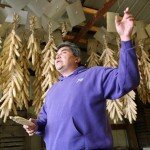Returning to their roots, health
Oneida embrace planting, harvesting of white corn as a staple of diet, culture
By Karen Herzog, Journal Sentinel

BY MARK HOFFMAN
ONEIDA, Wis. – George Washington’s troops at Valley Forge may have starved to death without the white corn an Oneida Indian chief gave them in the winter of 1777 during the Revolutionary War.
Now, the Oneida, like other tribes in Wisconsin, are returning to indigenous foods such as high-protein white corn and bison to aid their own survival, as diabetes and heart disease associated with fast food diets plague tribal members.
The heirloom corn can be traced back to the upstate New York homeland of the Oneida Nation before the colonists arrived. It is grown today on reservation land in three places in North America: upstate New York, Canada (Thames, Ontario), and Oneida near Green Bay, according to tribal officials.
Oneida from Wisconsin visited the New York reservation 16 years ago, and brought back seeds from the tribe’s seed bank. Each year, the Wisconsin Oneida plant six to eight acres of the corn. Tribal culture and ceremony are established around the planting and harvest, reconnecting Oneida to a past that had been lost to many.
“Even though we’ve been removed from New York, we’re still connected. The white corn goes back to the creation story to provide for our people,” said Vickie Cornelius, manager of the tribal cannery, which processes the corn for several food products.
The Oneida – one of the Six Nations of the Iroquois – came to Wisconsin in 1821, pressured by the government and white land speculators who demanded large portions of their homeland.
Today, at the Oneida organic farm in Wisconsin, white corn is picked by hand during a harvest and husking bee that attracts a few hundred Oneida and curious onlookers. A late fall breeze whispers through the corn stalks as ears are plucked, one by one, and stalks are stomped to the ground.
Once the corn is harvested, the husks are braided together by hand, and hung to dry in a storage shed. The corn is shelled by hand before being turned over to the tribal cannery.
Author: News Wire (24 Articles)


COMMENTS